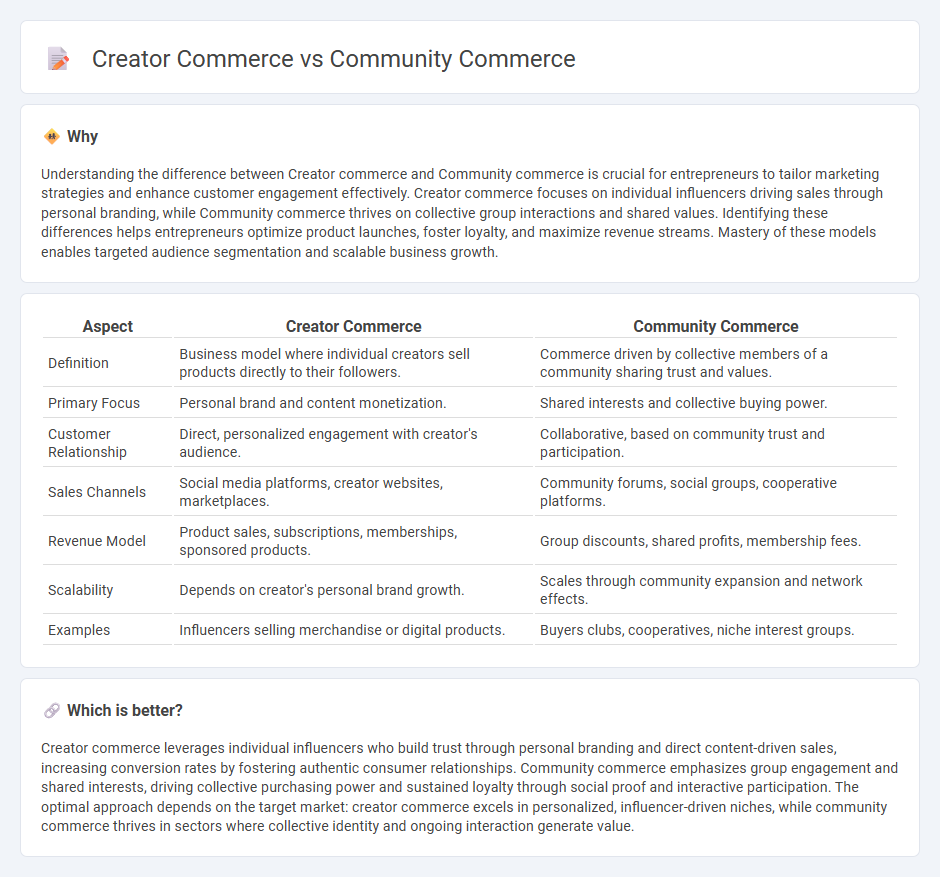
Creator commerce focuses on individual entrepreneurs leveraging personal brands to sell products directly to their audience, emphasizing authenticity and niche appeal. Community commerce centers on collective groups or networks that drive sales through shared interests and collaborative engagement, fostering trust and loyalty. Explore deeper insights into how these models shape the future of e-commerce.
Why it is important
Understanding the difference between Creator commerce and Community commerce is crucial for entrepreneurs to tailor marketing strategies and enhance customer engagement effectively. Creator commerce focuses on individual influencers driving sales through personal branding, while Community commerce thrives on collective group interactions and shared values. Identifying these differences helps entrepreneurs optimize product launches, foster loyalty, and maximize revenue streams. Mastery of these models enables targeted audience segmentation and scalable business growth.
Comparison Table
| Aspect | Creator Commerce | Community Commerce |
|---|---|---|
| Definition | Business model where individual creators sell products directly to their followers. | Commerce driven by collective members of a community sharing trust and values. |
| Primary Focus | Personal brand and content monetization. | Shared interests and collective buying power. |
| Customer Relationship | Direct, personalized engagement with creator's audience. | Collaborative, based on community trust and participation. |
| Sales Channels | Social media platforms, creator websites, marketplaces. | Community forums, social groups, cooperative platforms. |
| Revenue Model | Product sales, subscriptions, memberships, sponsored products. | Group discounts, shared profits, membership fees. |
| Scalability | Depends on creator's personal brand growth. | Scales through community expansion and network effects. |
| Examples | Influencers selling merchandise or digital products. | Buyers clubs, cooperatives, niche interest groups. |
Which is better?
Creator commerce leverages individual influencers who build trust through personal branding and direct content-driven sales, increasing conversion rates by fostering authentic consumer relationships. Community commerce emphasizes group engagement and shared interests, driving collective purchasing power and sustained loyalty through social proof and interactive participation. The optimal approach depends on the target market: creator commerce excels in personalized, influencer-driven niches, while community commerce thrives in sectors where collective identity and ongoing interaction generate value.
Connection
Creator commerce leverages influencers and content creators to directly sell products to engaged audiences, while community commerce builds trust and loyalty through shared values and interactions within niche groups. Both models rely on authentic relationships and social proof to drive purchasing decisions, enhancing customer retention and brand advocacy. Integrating creator-driven content within community platforms amplifies personalized marketing and deepens consumer engagement.
Key Terms
Peer-to-peer sales
Community commerce emphasizes peer-to-peer sales by leveraging trusted relationships within niche groups, fostering authentic recommendations and repeat purchases. Creator commerce, on the other hand, drives peer-to-peer transactions through influencer-driven content and direct engagement, transforming followers into buyers via personalized product endorsements. Explore the distinct mechanisms and benefits of both models to optimize your peer-to-peer sales strategy.
Influencer-driven marketing
Community commerce harnesses loyal customer groups to drive sales through authentic peer interactions, while creator commerce centers on content creators using personal influence to promote products directly. Influencer-driven marketing thrives in both models by leveraging trust and engagement to boost conversions and brand loyalty. Explore how these strategies can elevate your marketing efforts by discovering their unique benefits.
User-generated content
Community commerce thrives on user-generated content (UGC) that fosters authentic interactions and builds trust within niche groups, driving engagement and sales through peer recommendations. Creator commerce leverages influential individuals who produce original UGC to promote products directly to their followers, blending content creation with personalized marketing. Discover how harnessing the power of user-generated content can transform your commerce strategy by diving deeper into these models.
Source and External Links
Community commerce: A guide for brands and retailers - Community commerce is a creator-driven word-of-mouth marketing approach blending community, entertainment, shopping, and brand messaging to foster authentic product discovery and emotional connections with consumers through social media platforms.
What is Community Commerce and Why Should Brands Care - Community commerce, defined by TikTok, is a subset of social commerce centered on creator-driven recommendations that harness community connections to increase brand awareness and sales via authentic engagement.
Community Commerce Bank - TELACU - Community Commerce Bank is a California-based Community Development Financial Institution focused on providing loans and financial services to families and small businesses, supporting community economic growth since 1976.
 dowidth.com
dowidth.com